parking brake LEXUS LS430 2006 Owners Manual
[x] Cancel search | Manufacturer: LEXUS, Model Year: 2006, Model line: LS430, Model: LEXUS LS430 2006Pages: 419, PDF Size: 11.19 MB
Page 2 of 419
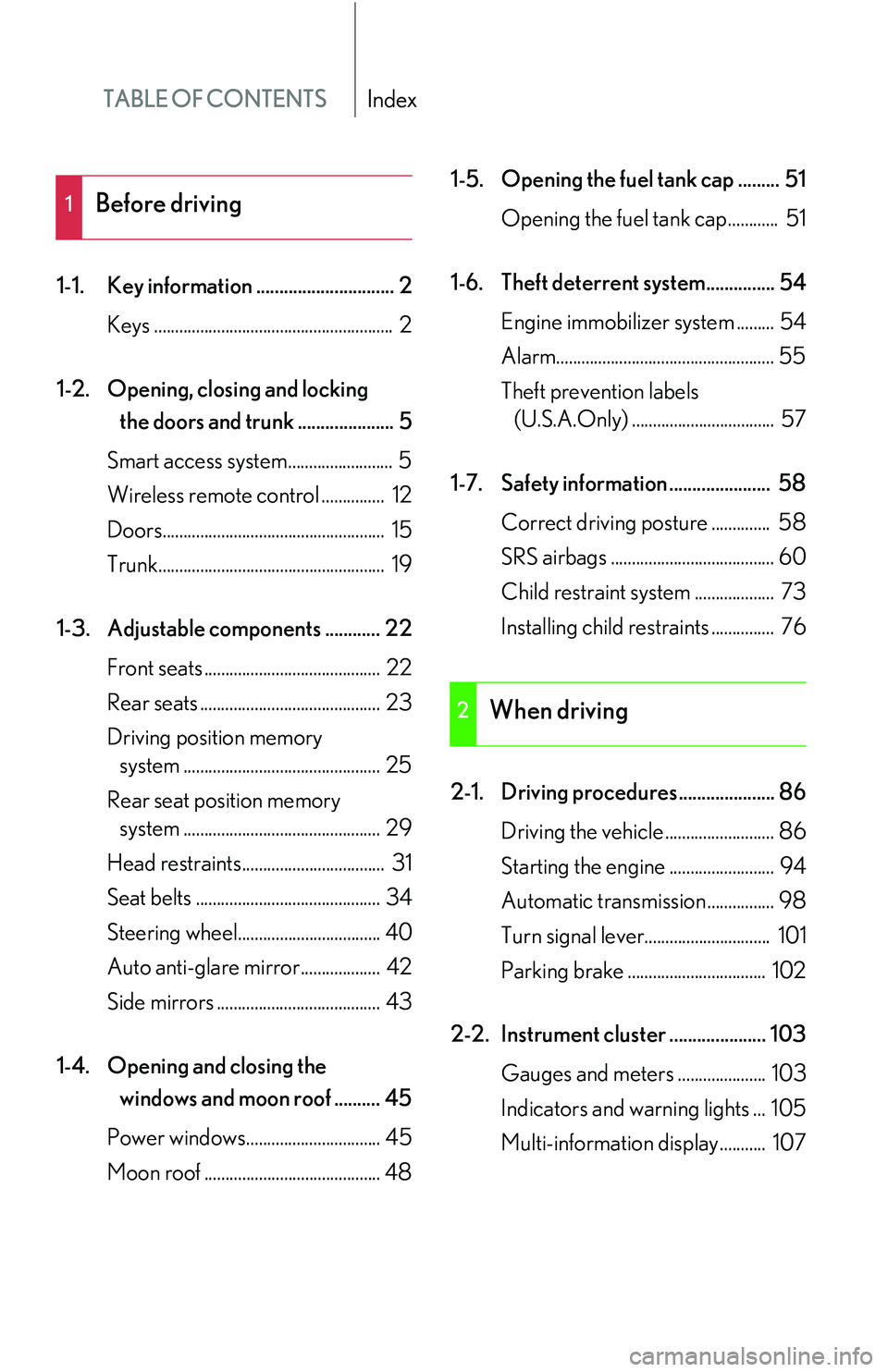
TABLE OF CONTENTSIndex
1-1. Key information .............................. 2Keys ......................................................... 2
1-2. Opening, closing and locking
the doors and trunk ..................... 5
Smart access system......................... 5
Wireless remote control ............... 12
Doors..................................................... 15
Trunk...................................................... 19
1-3. Adjustable components ............ 22 Front seats .......................................... 22
Rear seats ........................................... 23
Driving position memory
system ............................................... 25
Rear seat position memory
system ............................................... 29
Head restraints.................................. 31
Seat belts ............................................ 34
Steering wheel.................................. 40
Auto anti-glare mirror................... 42
Side mirrors ....................................... 43
1-4. Opening and closing the
windows and moon roof .......... 45
Power windows................................ 45
Moon roof .......................................... 48 1-5. Opening the fuel tank cap ......... 51
Opening the fuel tank cap............ 51
1-6. Theft deterrent system............... 54 Engine immobilizer system ......... 54
Alarm.................................................... 55
Theft prevention labels
(U.S.A.Only) .................................. 57
1-7. Safety information ...................... 58 Correct driving posture .............. 58
SRS airbags ....................................... 60
Child restraint system
................... 73
Installing child restraints ............... 76
2-1. Driving procedures..................... 86 Driving the vehicle .......................... 86
Starting the engine ......................... 94
Automatic transmission................ 98
Turn signal lever.............................. 101
Parking brake ................................. 102
2-2. Instrument cluster ..................... 103 Gauges and meters ..................... 103
Indicators and warning lights ... 105
Multi-information display........... 107
1Before driving
2When driving
Page 11 of 419
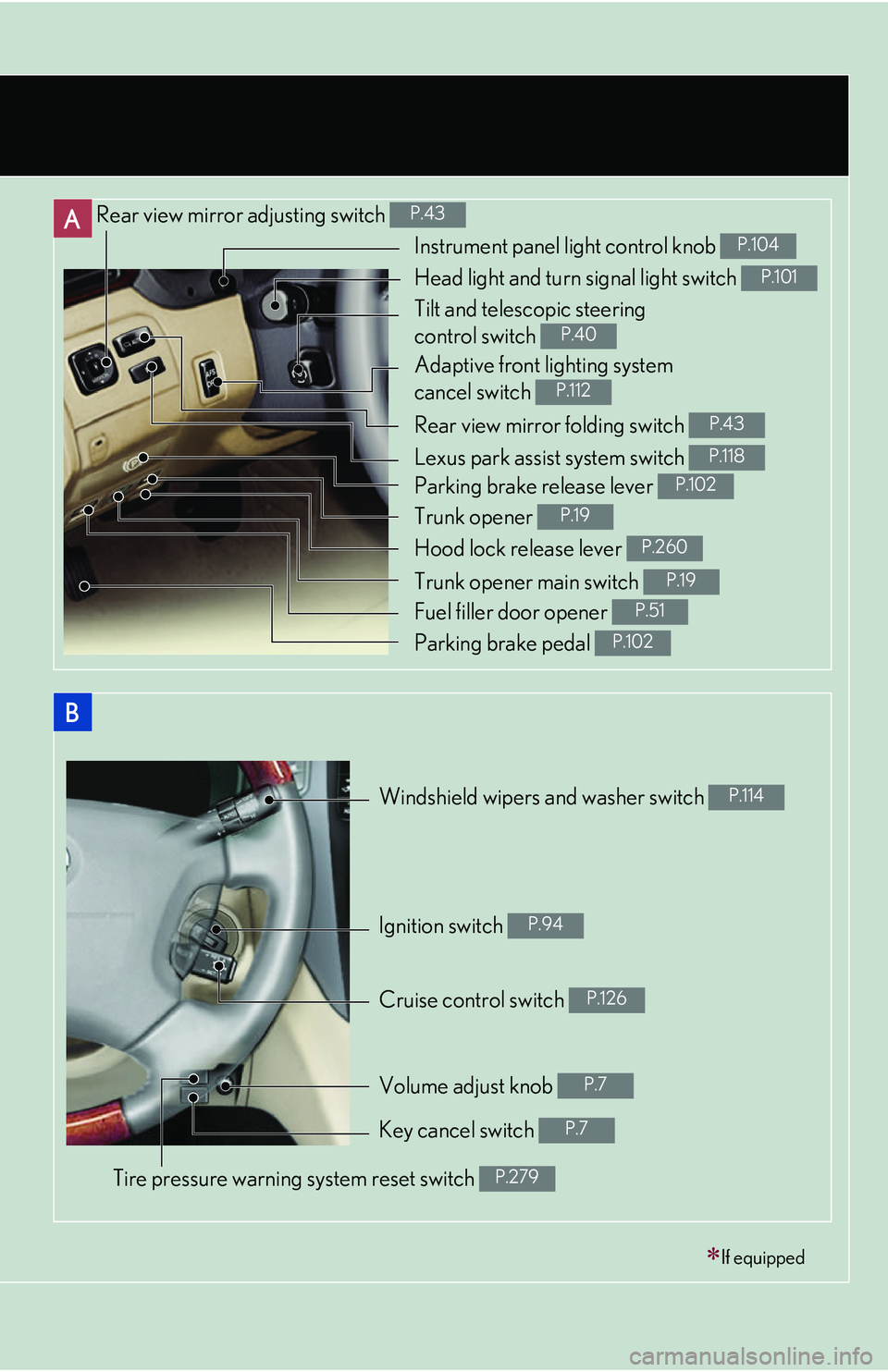
A
B
Rear view mirror adjusting switch P.43
Rear view mirror folding switch P.43
Windshield wipers and washer switch P.114
Cruise control switch P.126
If equipped
Instrument panel light control knob P.104
Head light and turn signal light switch P.101
Tilt and telescopic steering
control switch
P.40
Adaptive front lighting system
cancel switch
P.112
Lexus park assist system switch P.118
Parking brake release lever P.102
Trunk opener P.19
Hood lock release lever P.260
Trunk opener main switch P.19
Fuel filler door opener P.51
Parking brake pedal P.102
Ignition switch P.94
Volume adjust knob P.7
Key cancel switch P.7
Tire pressure warning system reset switch P.279
Page 101 of 419
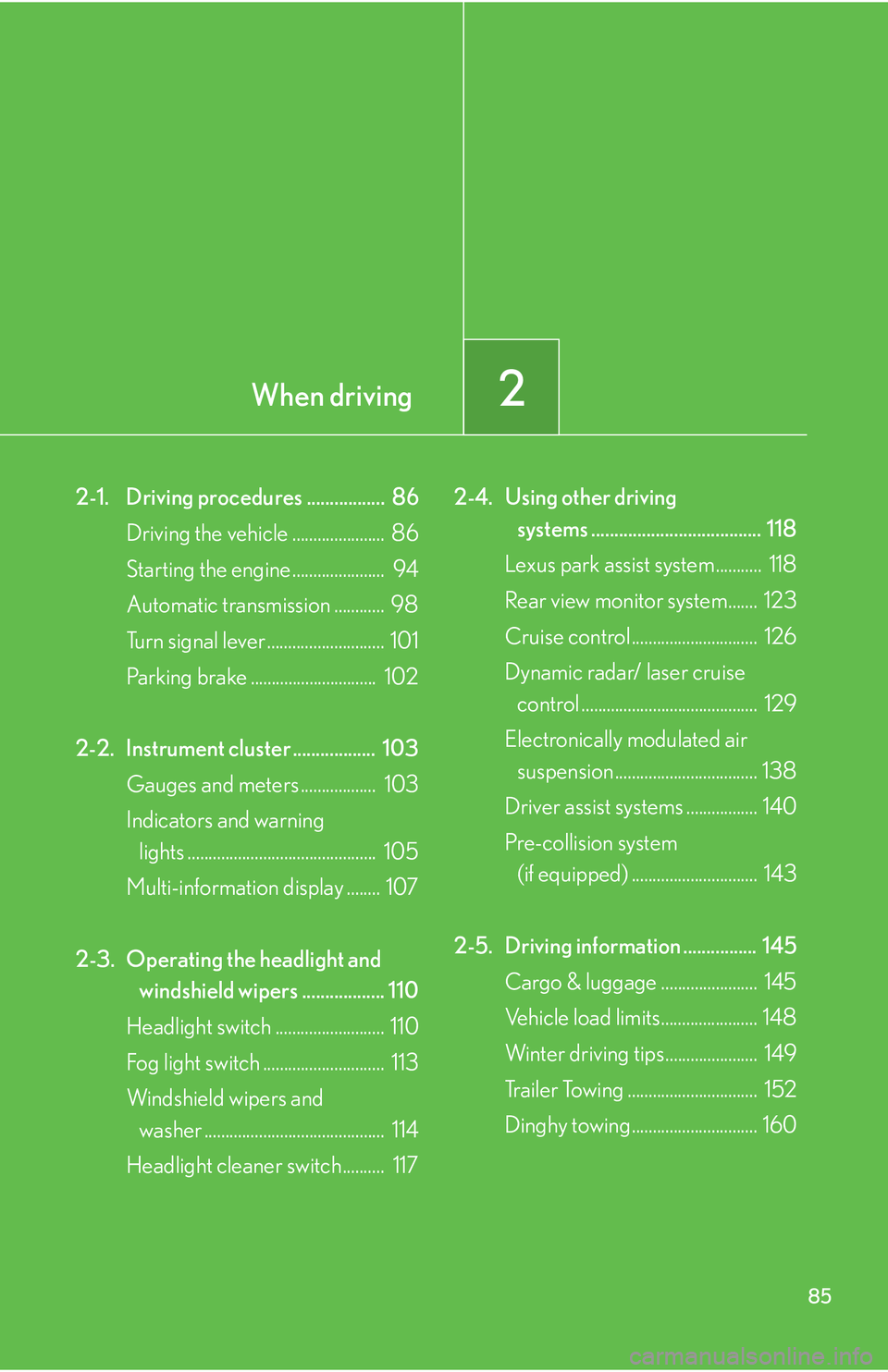
2When driving
85
2-1. Driving procedures ................. 86Driving the vehicle ...................... 86
Starting the engine ...................... 94
Automatic transmission ............ 98
Turn signal lever ............................ 101
Parking brake .............................. 102
2-2. Instrument cluster .................. 103 Gauges and meters .................. 103
Indicators and warning
lights ............................................. 105
Multi-information display ........ 107
2-3. Operating the headlight and
windshield wipers .................. 110
Headlight switch .......................... 110
Fog light switch ............................. 113
Windshield wipers and
washer ........................................... 114
Headlight cleaner switch.......... 117 2-4. Using other driving
systems ..................................... 118
Lexus park assist system ........... 118
Rear view monitor system....... 123
Cruise control .............................. 126
Dynamic radar/ laser cruise
control .......................................... 129
Electronically modulated air
suspension.................................. 138
Driver assist systems ................. 140
Pre-collision system
(if equipped) .............................. 143
2-5. Driving information ................ 145 Cargo & luggage ....................... 145
Vehicle load limits....................... 148
Winter driving tips...................... 149
Trailer Towing ............................... 152
Dinghy towing.............................. 160
Page 102 of 419
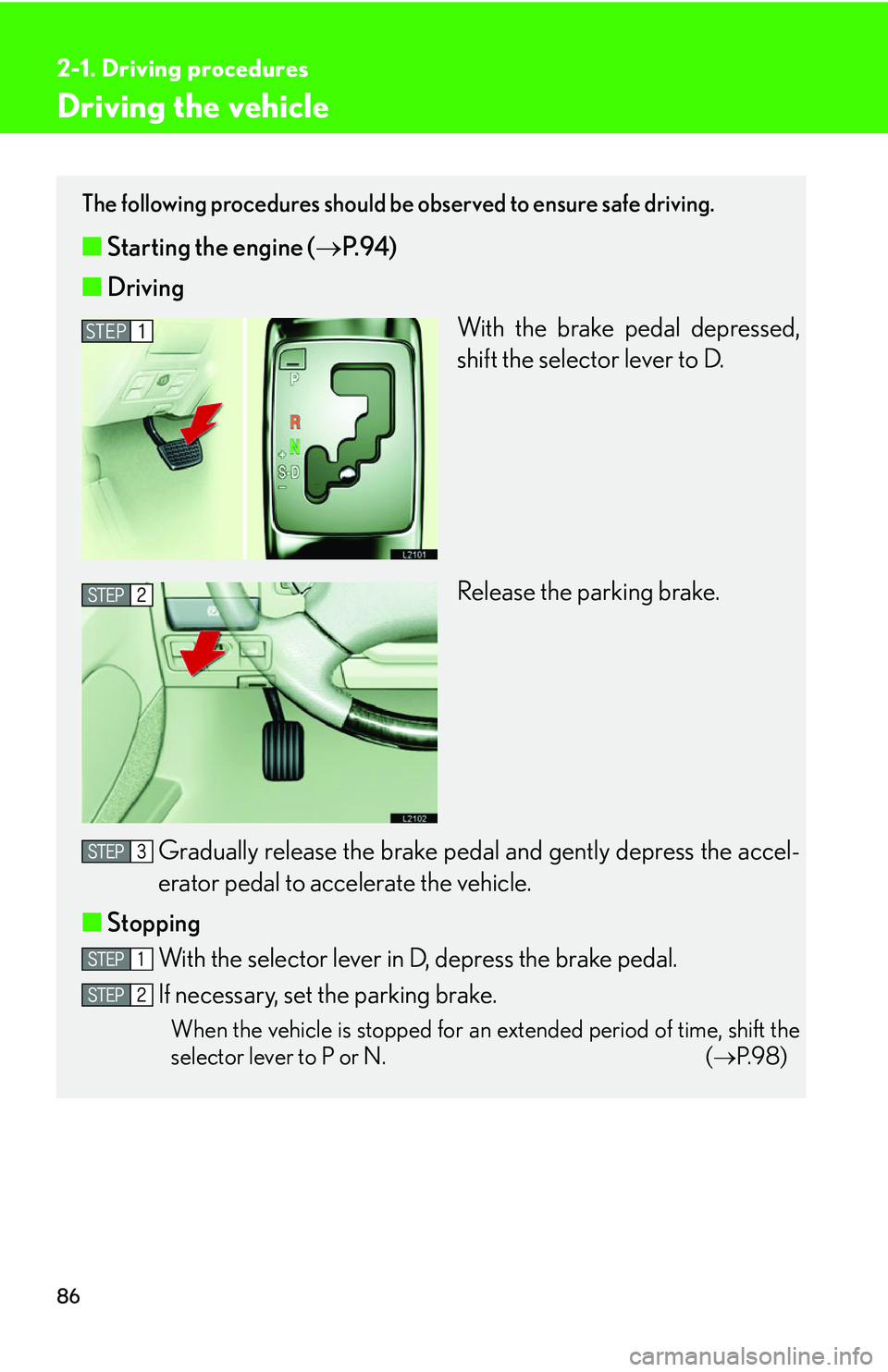
86
2-1. Driving procedures
Driving the vehicle
The following procedures should be observed to ensure safe driving.
■Starting the engine ( P.94 )
■ Driving
With the brake pedal depressed,
shif
t the selector lever to D.
Release the parking brake.
Gradually release the brake peda l and gently depr
ess the accel-
erator pedal to accelerate the vehicle.
■ Stopping
With the selector lever in D, depress the brake pedal.
If necessary, set the parking brake.
When the vehicle is stopped for an extended period of time, shift the
selector lever to P or N. (
P. 9 8 )
STEP1
Page 103 of 419

87
2-1. Driving procedures
2
When driving
Starting on a steep incline
Firmly set the parking brake and
shift the selector lever to D.
Gently depress the accelerator pedal.
Release the parking brake.
■ Parking the vehicle
With the selector lever in D, depress the brake pedal.
Set the parking brake. (
P.102 )
Shift the selector lever to P. (
P.98 )
Stop the engine.
Page 105 of 419
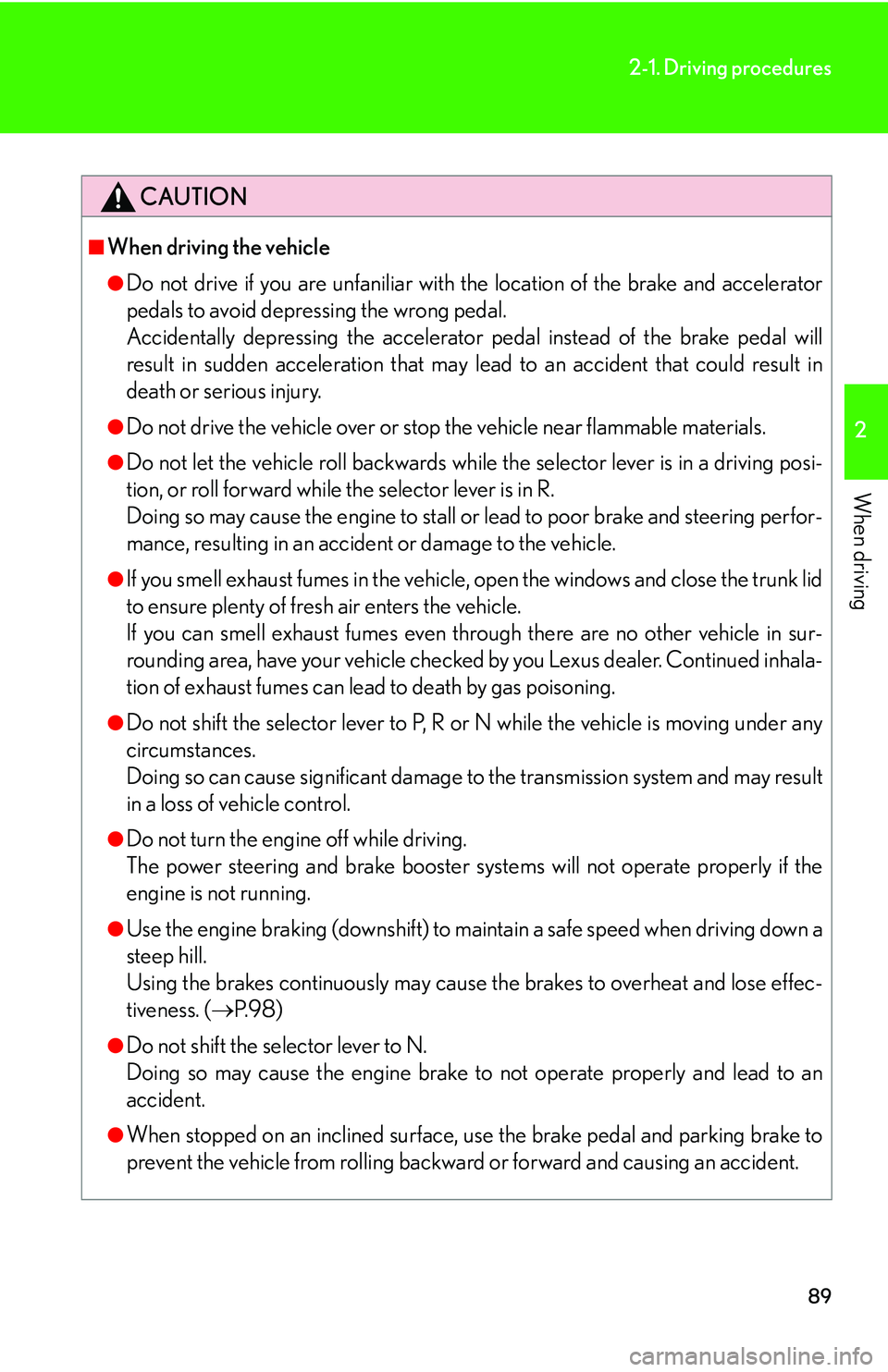
89
2-1. Driving procedures
2
When driving
CAUTION
■When driving the vehicle
●Do not drive if you are unfaniliar with the location of the brake and accelerator
pedals to avoid depressing the wrong pedal.
Accidentally depressing the accelerator pedal instead of the brake pedal will
r
esult in sudden acceleration that may lead to an accident that could result in
death or serious injury.
●Do not drive the vehicle over or stop the vehicle near flammable materials.
●Do not let the vehicle roll backwards while the selector lever is in a driving posi -
tion, or roll forward while the selector lever is in R.
Doing so may cause the engine to stall or lea
d to poor brake and steering perfor-
mance, resulting in an accident or damage to the vehicle.
●If you smell exhaust fumes in the vehicle, open the windows and close the trunk lid
to ensure plenty of fresh air enters the vehicle.
If you can smell exhaust fumes even through there are no other vehicle in sur -
rounding area, have your vehicle checke d b
y you Lexus dealer. Continued inhala-
tion of exhaust fumes can lead to death by gas poisoning.
●Do not shift the selector lever to P, R or N while the vehicle is moving under any
circumstances.
Doing so can cause significant damage to the tr
ansmission system and may result
in a loss of vehicle control.
●Do not turn the engine off while driving.
The power steering and brake booster systems will not operate properly if the
eng
ine is not running.
●Use the engine braking (downshift) to maintain a safe speed when driving down a
steep hill.
Using the brakes continuously may cause the brakes to overheat and lose effec -
tiveness. ( P.98 )
●Do not shift the selector lever to N.
Doing so may cause the engine brake to not operate properly and lead to an
acc
ident.
●When stopped on an inclined surface, use the brake pedal and parking brake to
prevent the vehicle from rolling backward or forward and causing an accident.
Page 107 of 419

91
2-1. Driving procedures
2
When driving
CAUTION
■When the vehicle is parked
●Do not leave glasses, cigarette lighters, spray cans, or soft drink cans in the vehi-
cle in hot areas.
• Gas may leak from a cigarette lighter or spr
ay can, and may lead to a fire.
• The temperature inside the vehicle may cause the plastic lenses and plastic
m
aterial of glasses to deform or crack.
• Soft drink cans may fracture, causing the co ntents
to spray over the interior of
the vehicle, and may also cause a short circuit in the vehicle’s electrical com -
ponents.
●Always set the parking brake, shift the se lector lever to P, stop the engine and
lock the vehicle.
Do not leave the vehicle unattend ed
while the engine is running.
●Do not leave the engine running in an area with snow build up, or where snow is
expected to fall.
Exhaust gases may enter the interior of the vehicle and cause gas poisoning.
■When taking a nap in the vehicle
Always turn the engine off. Otherwise, you may accidentally move the selector
le
ver or press the accelerator pedal, which could cause an accident or fire due to
abnormal engine overheating. Additionally, if the vehicle is parked in a poorly venti-
lated area, exhaust fumes may enter the vehicle and cause gas poisoning.
Page 108 of 419
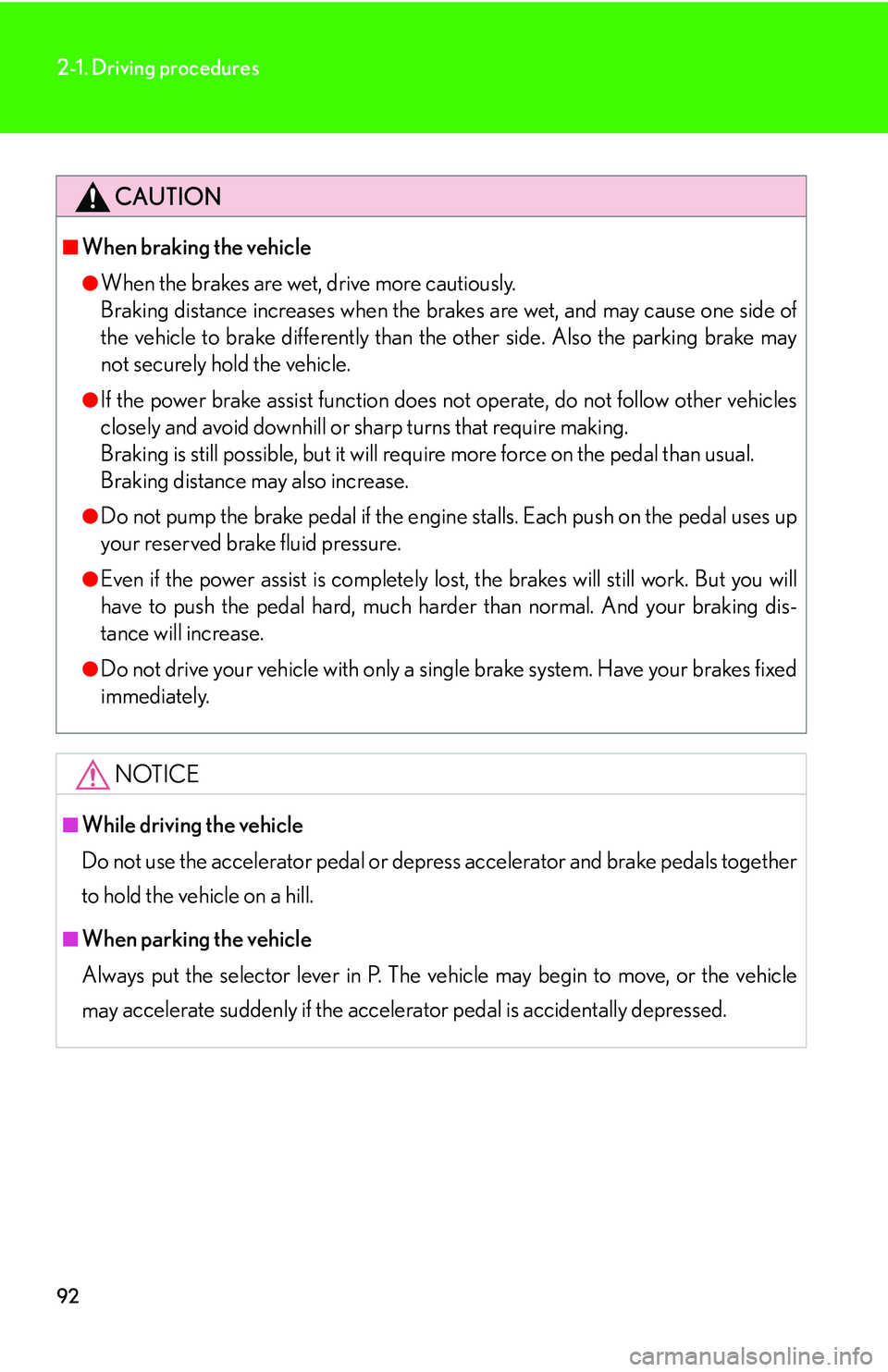
92
2-1. Driving procedures
CAUTION
■When braking the vehicle
●When the brakes are wet, drive more cautiously.
Braking distance increases when the brakes are wet, and may cause one side of
th
e vehicle to brake differently than the other side. Also the parking brake may
not securely hold the vehicle.
●If the power brake assist function does not operate, do not follow other vehicles
closely and avoid downhill or sharp turns that require making.
Braking is still possible, but it will re quir
e more force on the pedal than usual.
Braking distance may also increase.
●Do not pump the brake pedal if the engine stalls. Each push on the pedal uses up
your reserved brake fluid pressure.
●Even if the power assist is completely lost, the brakes will still work. But you will
have to push the pedal hard, much hard er than normal. And your braking dis-
tance will increase.
●Do not drive your vehicle with only a single brake system. Have your brakes fixed
immediately.
NOTICE
■While driving the vehicle
Do not use the accelerator pedal or depres s acceler
ator and brake pedals together
to hold the vehicle on a hill.
■When parking the vehicle
Always put the selector lever in P. The vehicle may begin to move, or the vehicle
ma
y accelerate suddenly if the accelerat or pedal is accidentally depressed.
Page 110 of 419
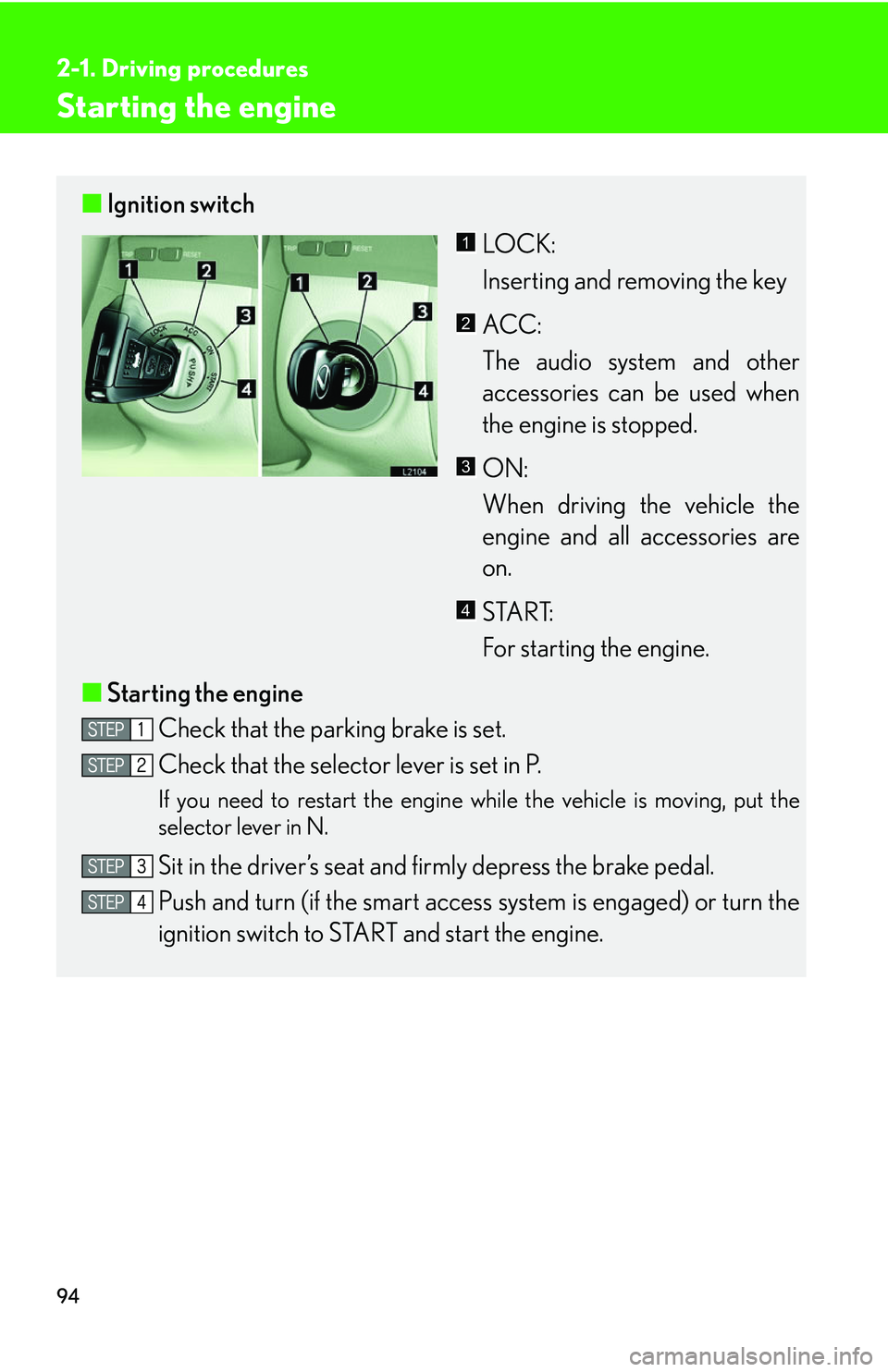
94
2-1. Driving procedures
Starting the engine
■Ignition switch
LOCK:
Inserting and removing the key
ACC:
The audio system and other
acces
sories can be used when
the engine is stopped.
ON:
When driving the vehicle the
engine an
d all accessories are
on.
START:
For starting the engine.
■ Star
ting the engine
Check that the parking brake is set.
Check that the selector lever is set in P.
If you need to restart the engine while the vehicle is moving, put the
selector lever in N.
Sit in the driver’s seat and firmly depress the brake pedal.
Push and turn (if the smart access s
ystem is engaged) or turn the
ignition switch to STAR T and star
t the engine.
1
2
3
4
Page 114 of 419
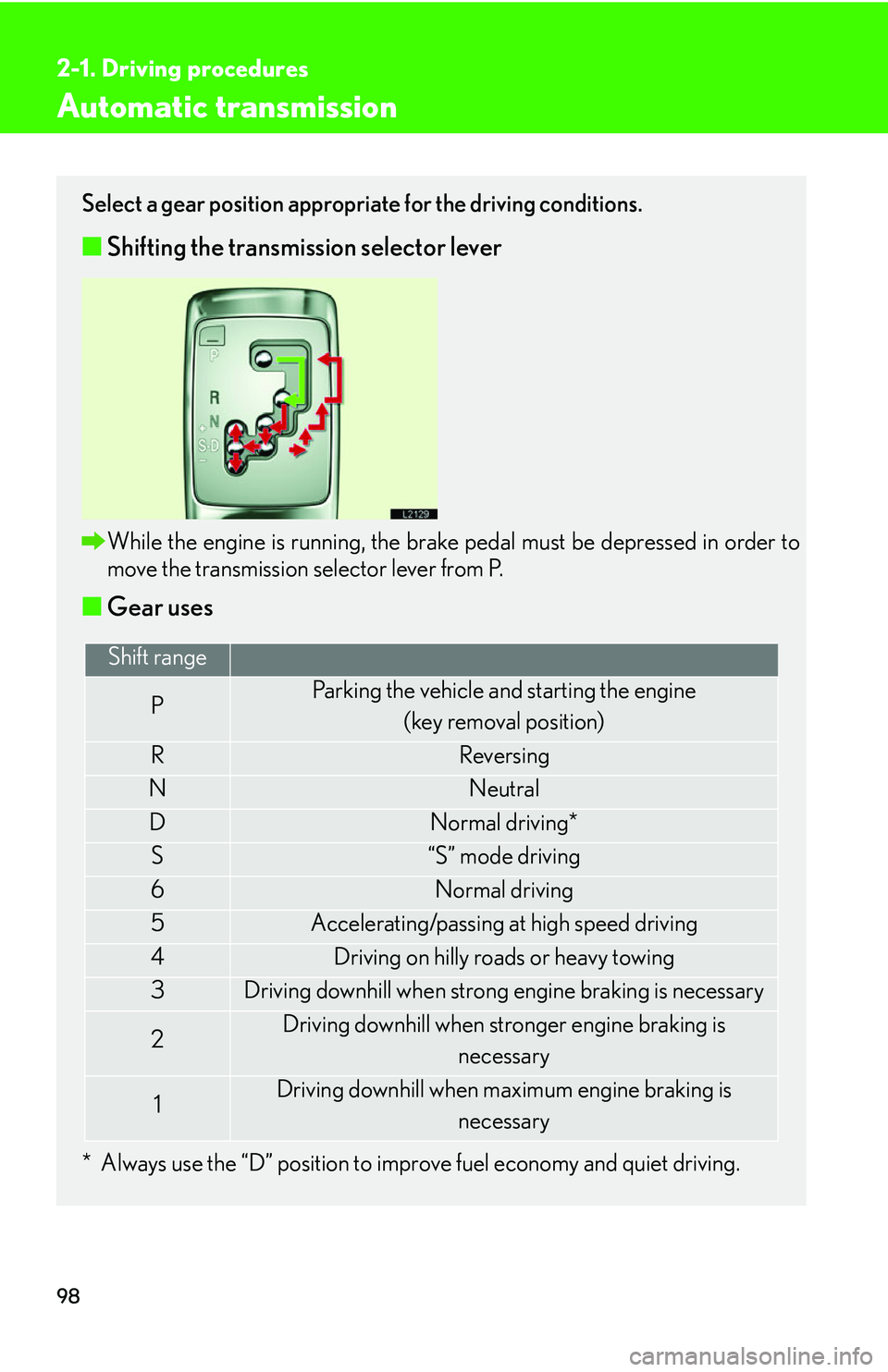
98
2-1. Driving procedures
Automatic transmission
Select a gear position appropriate for the driving conditions.
■Shifting the transmission selector lever
While the engine is running, the brake pedal must be depressed in order to
move the transmission selector lever from P.
■Gear uses
* Always use the “D” position to improve fuel economy and quiet driving.
Shift range
PParking the vehicle and starting the engine
(key removal position)
RReversing
NNeutral
DNormal driving*
S“S” mode driving
6Normal driving
5Accelerating/passing at high speed driving
4Driving on hilly roads or heavy towing
3Driving downhill when strong engine braking is necessary
2Driving downhill when stronger engine braking is necessary
1Driving downhill when maximum engine braking is
necessary